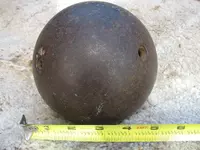Quite literally,
millions of iron/steel balls have been manufactured for Civilian usage/purposes... never intended to be artillery projectiles. Some examples of non-artillery balls:
Mining-&-Stonemilling Industry rock-crusher balls (called Mill-balls)
Ornamental Ironwork balls (such as a gatepost-top)
Sports Shot Put balls
Counterweight balls.
So, we cannonball collectors had to find a 100%-reliable way to tell actual cannonballs from the various other kinds of iron balls. The answer is to consult Historical artillery data, which gives us the
very precise diameter and
very-exact weight of of every kind of cannonball ever used in battle in America.
www.civilwarartillery.com/shottables.htm
Because super-precise measuring is crucially necessary, we "serious" collectors use super-precise tools. To measure the ball's weight, we use a digital Postal Shipping Scale, which measures in 1/10th-ounce graduations. You
cannot trust household bathroom weighing-scales, which are typically inaccurate by 5% (especially when the object weighs less than 50 pounds).
For diameter, we use:
1- a Digital Caliper, which measures in (at least) 1/100th-of-an-inch increments.
2- if the ball is too large for a Digital Caliper, we use a Diameter-Tape (also called a Pi Tape).
If the ball is indeed an Artillery projectile (cannonball, grapeshot-ball, canister-ball), its precise measurements will match up (within a very few 100ths-inch and a few ounces) with one of the Artillery ball sizes specified by the Army and Navy Artillery Ordnance Departments in the historical records.
You will need to do the super-precise diameter and weight measuring. For detailed instructions on how to do the measuring
correctly, please read this Educational article:
SolidShotEssentialsMod
When you've gotten the ball's very-exact diameter and weight measurements, go to the following webpage and look for a precise match-up. (The sizes given include Civil War, and some War-of-1812 and Revolutionary War artillery balls.) If there is no match-up, the ball is not a cannonball.
www.civilwarartillery.com/shottables.htm
Meanwhile... your photos show one hole, approximately 3/8-inch wide or a bit less, in the ball. Are there any other holes in the ball, or is that the only one? I'm asking because I've seen some non-artillery balls which have four small holes, spaced equidistantly around thei ball's equator ...meaning, 90 degrees apart. You may need to look closely for the other holes, because they're often plugged up with rust/dirt-crust.


